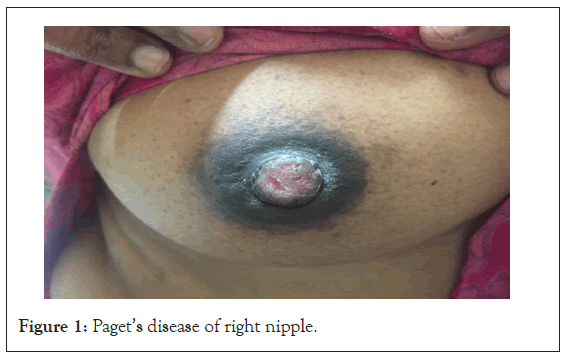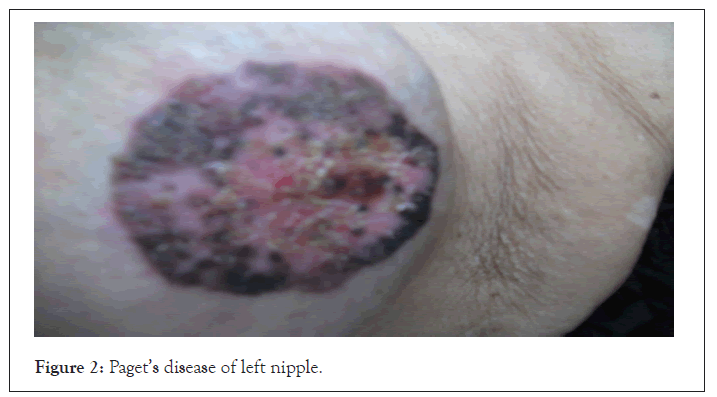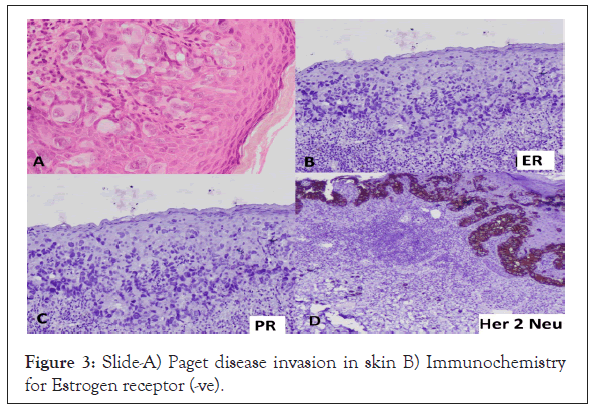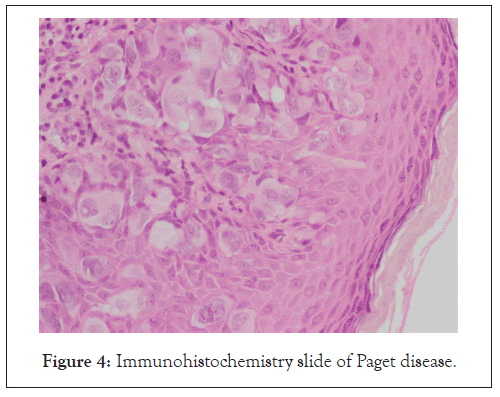Indexed In
- Open J Gate
- Genamics JournalSeek
- JournalTOCs
- RefSeek
- Hamdard University
- EBSCO A-Z
- OCLC- WorldCat
- Publons
- Geneva Foundation for Medical Education and Research
- Google Scholar
Useful Links
Share This Page
Journal Flyer

Open Access Journals
- Agri and Aquaculture
- Biochemistry
- Bioinformatics & Systems Biology
- Business & Management
- Chemistry
- Clinical Sciences
- Engineering
- Food & Nutrition
- General Science
- Genetics & Molecular Biology
- Immunology & Microbiology
- Medical Sciences
- Neuroscience & Psychology
- Nursing & Health Care
- Pharmaceutical Sciences
Case Report - (2021) Volume 12, Issue 5
Paget's Disease of the Breast: A Retrospective Study with Case Report and Review
Sunder Goyal1*, Vikas Tyagi1 and Snigdha G22Department of Pathology, Civil Hospital, Haryana, India
Received: 12-Jul-2021 Published: 02-Aug-2021, DOI: 10.35248/2155-9627.21.12.378
Abstract
Paget's Breast Disease (PBD) is a rare disease with an unusual presentation, makings the diagnosis difficult. A biopsy provided the definitive diagnosis of patients, and the treatments depend upon the histological findings and underlying breast mass. Modified radical mastectomy and simple mastectomy for invasive carcinoma and carcinoma-in-situ, respectively, are the treatment of choice. We did a retrospective study from 2017 to 2019, and only two cases of Paget's breast disease were there out of a total of 147 carcinoma breasts.
Keywords
Paget's breast disease; Biopsy; Modified radical mastectomy; Simple mastectomy
Introduction
Sir Paget first described Paget's disease of the nipple in 1874.It is a malignant disease that presents itself as eroding and bleeding ulcer of the nipple and areola. It may be an extension of underneath ductal breast adenocarcinoma. Microscopically, typical large clear cells (Paget's cells) with pale and abundant cytoplasm and hyper chromatic nuclei with prominent nucleoli are seen in the epidermal layer. Paget's disease is mostly accompanied by primary invasive or in situ carcinoma of the breast. As a non- invasive form of cancer, Paget's is not an aggressive or fast- spreading disease. PDB presents most commonly in postmenopausal women between 50 and 60 years old, with a median age of 56-57 years. Only 1%-4% of patients with breast cancer present with PDB. However, 92%-100% of PDB cases are associated with ductal carcinoma in situ and IDC. PDB should be suspected in any patient with chronic, cutaneous breast changes that do not respond promptly to topical treatments. PDB involving the nipple has been commonly associated with IDC and is thought to be because of epidermal extension of underlying ductal breast carcinoma. Ultrasounds, mammography, and magnetic resonance imaging can search for underlying cancer and guide surgical management. A biopsy is mandatory to confirm the diagnosis, particularly in cases without an associated lump. The surgical treatment of Paget's disease is not clear, whether radical or conservative. Palpable mass and the invasiveness of cancer predict and decide about prognosis. Our all, only the two cases are classical PDB without any lump underneath [1-8].
Case Presentation
A retrospective study was carried out from 2017 to 2019 in a tertiary medical college. Total 147 cases of malignancy were reported, and only two cases of Paget's breast disease reported. Two patients, 62-year and 59 year-old females with no family history of cancer, presented with a modification of one left and one right breast's nipple-areola, respectively. The examination revealed an eczematous aspect of the right and left breasts with an eroded nipple suggesting Paget's disease (Figures 1 and 2). There was no supraclavicular, cervical, or axillary lymphadenopathy. A thorough breast examination did not reveal a palpable mass. An ultrasound and mammograms of breasts did not reveal any lump. Biopsy concluded PDB (Figure 3). Tissue was positive for Estrogen and Progesterone receptors but negative for HER2 receptors (Figure 4). Mastectomy was performed without complications. Final histology concluded DCIS associated with Paget's disease. The Sentinel lymph node was negative. There was no distance spread in the body. The patients were put on systemic adjuvant chemotherapy
Figure 1: Paget’s disease of right nipple.
Figure 2: Paget’s disease of left nipple.
Figure 3: Slide-A) Paget disease invasion in skin B) Immunochemistry for Estrogen receptor (-ve).
Figure 4: Immunohistochemistry slide of Paget disease.
Results and Discussion
Common age for PBD is about 50-60 years, but uncommon cases have been reported in their 20s. Paget's disease was reported in 1,874 by James Paget as an eczematous lesion of the nipple with or without an underlying lump. Paget's breast disease is a malignant disease that starts as eroding and bleeding ulcer of the nipple. It accounts for 1 to 4.3% of all breast cancer. It may be an extension of ductal breast adenocarcinoma. Histopathologically slide is full of large clear cells (Paget's cells) with pale and abundant cytoplasm and hyper chromatic nuclei with prominent nucleoli. The breast's primary invasive or in situ carcinoma may be associated with Paget's nipple disease. Immunohistochemistry of Paget cells and underlying cancer may show a more aggressive, HER2-enriched, molecular subtype of breast cancer [9,10].
Paget's disease of the nipple develops slowly without any early symptom. Mostly it starts as an eczematous erythema oozing patch of one side nipple first and then slowly start involving and spread centrifugally to invade the areola and the adjacent skin. The color of the skin changes from pink to red. Retraction, ulceration, or bleeding of the nipple occurs as disease progression. Some women have a burning sensation, tingling, increased sensitivity and pain in the late stage of the disease due to serious skin destruction. Lumps or masses in the same breast occur in more than 50% of the patients. The symptoms may wax and wane along with redness, oozing, crusting, and a non-healing nipple sore.
Paget cells are characteristics of PBD. These cells are large cells with clear cytoplasm (clear halo) and eccentric, hyper chromic nuclei found throughout the epidermis. There is disagreement about the source of these cells. It is unclear whether these cells arise from the breast's ductal system or whether they result from in situ malignant transformations. According to the widely accepted migratory theory, the ductal carcinoma in situ cells from the original tumor travel through milk ducts to the nipple and its surrounding skin. Cancer cells disturb the normal epithelial barrier, and extracellular fluid builds up on the skin's surface and cause the crusting of the areola skin [11,12].
Paget cells possess glandular cells' features and show positivity for HER2 oncogene. The exact mechanisms are not clear, but interactions between heregulin-alpha protein produced by nipple epidermal keratinocytes and HER2 on the tumour cells have been drawn in the chemotaxis.
Various risk factors
• Age-chances more advancing age.
• A personal history of breast Cancer.
• Family history of breast cancer.
• Dense breast tissue.
• Obesity.
• Exposure to radiation.
• Race-caucasian women have a higher risk of breast cancer.
• Using combination estrogen-progestin hormone replacement therapy after menopause.
• Drinking much alcohol.
Most breast cancer cases don’t pass on in families, but genes known as BRACA1 and BRCA2 can increase breast and ovarian cancer risk. These genes can be delivered from one parent to their child. The presence of genes TP53 and CHEK2 also increase the risk of breast cancer.
Atypical ductal hyperplasia of breast or lobular carcinoma in situ increases the chances of breast malignancy.
Dense breast tissue
Females with dense breast tissue have a higher risk of developing breast cancer as more cells can become cancerous. Mammogram study is difficult in dense breast tissue, and lumps or abnormal tissue areas are harder to see.
Younger women tend to have denser breasts. As grow older, the amount of glandular tissue in breasts decreases and is replaced by fat.
Hormones and hormone medicine
Exposure to oestrogen: Early menarche and late menopause expose to oestrogen for a longer period thus increase the chances of cancer. Spinsters are at higher risk of breast cancer.
Hormone Replacement Therapy (HRT) increases breast malignancy risk except for the local application of vaginal oestrogen cream. Up to one year, HRT does not increase risk, but this increases with prolonged use.
The high risk of breast malignancy falls after stopping HRT.However, some high risk remains for more than 10 years compared to women who have never used hormone therapy.
Similarly, females who take the contraceptive pill have a slightly increased risk of breast cancer. However, the risk starts to reduce once one stop taking the pill and everything is normal 10 years after stopping.
Life style factors
Being overweight or obese: With menopause, if there is obesity, there is a high risk and as obese produce more oestrogen after menopause.
Alcohol: People who take even small amounts of alcohol regularly have a higher risk than in teetotalers: the more alcohol one drinks, the more chances of getting breast cancer.
Radiation: The use of radiation, such as X-rays and CT scans, may slightly enhance breast cancer risk. The patient taking radiotherapy to the chest area for Hodgkin lymphoma is more prone to develop breast cancer.
Staging: If underlying carcinoma is identified, staging is based on its features.
The presence of Paget disease does not influence staging
• If no underlying carcinoma is identified, the stage is Tis (Paget's).
Diagnosis
A nipple biopsy is essential for the diagnosis of PBD. There are several types of nipple biopsy as below:
Nipple discharge samples may show the presence of the Paget cells.
• Surface biopsy: A glass slide is used to scrape cells from the surface of the eczematous skin gently.
• Shave biopsy: The top layer of eczematous skin is taken with a razor-like sharp tool.
• Punch biopsy: A punch is used to remove a disk-shaped piece of the nipple and eczematous skin.
• Wedge biopsy: A blade is used to remove a small wedge of the nipple and eczematous skin. This is most informative as a good amount of tissue is available.
Most people who have PBD also have one or more tumors inside the same breast. In addition to a nipple biopsy, a clinical breast exam breast is carried out to check for lumps or other breast changes. About 50 percent of patients with PBDs have an associated breast lump that can be felt in a clinical breast exam. An ultrasound exam, or mammogram, or magnetic resonance imaging scan is mandatory in cases with a palpable lump in the breast [13,14].
As seen in our patient, most patients with cutaneous changes limited to only the nipple and without a palpable mass will have a normal mammogram [3,6,15].
The immunohistochemistry is essential to distinguish Paget cells from other cell types like Toker cells which are normally present, and that can be difficult to distinguish from Paget's disease. CD138 and p53 are used as positive in Paget's disease and negative in normally present Toker cells. Also, Paget cells stain positive for CK7 in >90% of the cases. Likewise, GATA3 and HER-2 are expressed in around 90% of the cases and are used for confirmation, including CK7 negative Paget disease [16,17].
Our cases study highlights the importance of histologic examination via incisional or deep punch biopsy to confirm PDB diagnosis, regardless of a prior normal mammogram or breast ultrasound. Most patients with PBD without a palpable mass will have a normal mammogram as in our cases [3,6,15].
The mammography is useful and sensitive to detect underlying carcinoma associated with PDB. Magnetic Resonance Imaging (MRI) is highly sensitive for detecting breast cancer, especially in patients with a normal mammogram. However, negative or normal imaging studies alone cannot rule out PDB in a patient presenting with cutaneous breast changes. They should be correlated with biopsy and clinical findings to establish a PDB diagnosis. A punch, wedge, or shave biopsy of the involved tissue can be performed; it is important to obtain a full-thickness biopsy of the nipple and areola to establish the diagnosis. It is important to consider that a shave biopsy of the nipple will often not include the entire epidermis and may yield an inadequate sample. If the first biopsy does not contain adequate tissue, a repeat wedge biopsy or excision of the nipple may be necessary for patients without mass [2,15].
Treatment
Till recently, mastectomy, with or without the removal of axillary lymph nodes on the same side, was looked upon as the standard surgery for PBD. Most patients were associated with tumors inside the same breast. Even if only one tumor was present, that tumor could be located several centimeters away from the nipple and areola. It would not be removed by surgery on the nipple and areola alone.
However, in patients with PBD without a lump with negative mammograms, the breast-conservative followed by whole breast radiation therapy may be the treatment of choice [18-20].
In patients with PBD with a breast tumor a mastectomy with sentinel lymph node biopsy should be done to find spread in axillary lymph nodes. Axillary clearance is done if the sentinel node is positive. Adjuvant therapy, consisting of chemotherapy and/or hormonal therapy, may also be advocated depending upon the stage, positive lymph nodes, estrogen and progesterone receptors in tissue and HER2 protein over expression in the tumor cells [21,22].
Prognosis
The prognosis of PBD depends upon the following factors:
• Whether or not a tumor is present in the affected breast
• If one or more tumors are present in the affected breast, whether those tumors are DIC in situ or invasive breast cancer
• The stage of that cancer in case of invasive breast carcinoma.
Their survival rate is low if PBD co-exists with invasive carcinoma with positive axillary lymph nodes.
The 5-yeards survival rate for PBD is about 82.6 percent, where for other breast cancer is 87.1 percent. In patients PBD with invasive cancer in the same breast, the 5-year relative survival declined with increasing cancer stage-stage I, 95.8 percent; stage II, 77.7%; stage III, 46.3%; stage IV, 14.3% [18,23,24].
Conclusion
PBD is an uncommon breast cancer which is mostly accompanied with underneath breast cancer. In PBD cases with normal ultrasound and mammogram, a wedge biopsy of nipple is essential to establish the diagnosis.
REFERENCES
- Dubar S, Boukrid M, Joliniere J, Guillou L, Vo QD, et al. A Paget's Breast Disease: A Case Report and Review of the Literature. Front Surg. 2017; 4: 51.
- Karakas C. Paget's disease of the breast. J Carcinog. 2011; 10(1): 31.
- Wong G, Drost L, Yee C, Lam E, Kenzie M, et al. Are we properly diagnosing and treating Paget's disease of the breast? A case series. J Pain Manag. 2019; 12(2):169-172.
- Challa, VR, Deshmane V. Challenges in diagnosis and management of Paget's disease of the breast-A retrospective study. Indian J Surg. 2015; 77(3): 1083-1087.
- Ackerman L, Rosai J, Goldblum J, Lamps L, Myers J, et al. Rosai and Ackerman's surgical pathology (11th edition) . 2018.
- Carreras PA, García LB, Pérez LI, Barrales CC, Sánchez TJ. Paget's disease of the breast: A dangerous imitator of eczema. Sultan Qaboos Univ Med J. 2017; 17(4): e487–e488.
- Bolognia J, Schaffer JV, Cerroni L. Dermatology (4th edition). 2018.
- Sylvana BA, Mercurio MG. Paget's Disease of the breast presenting as nipple ulceration with normal mammogram. J Dermatol Nurs Assoc. 2020; 12(3): 121-123.
- Alvero R. Paget's disease of the breast. Ferri's Clinical Advisor (2017).
- Arafah M, Arain SA, Raddaoui EM, Tulba A, Alkhawaja FH.Molecular subtyping of mammary Paget's disease using immunohistochemistry. Saudi Med J. 2019; 40 (5): 440-446.
- Costa MJC, Cuzzi T, Carneiro S, Parish LC, Silva RM. Paget's disease of the breast. Skinmed. 2012; 10 (3): 160–165.
- Kumar V, Abbas BK, Fausto N, Mitchell R. Robbins basic pathology (8th edition). 2007.
- Harris JR, Lippman ME, Morrow M, Osborne CK. Diseases of the Breast. 4th editon. Philadelphia: Lippincott Williams & Wilkins. 2009.
- Caliskan M, Gatti G, Sosnovskikh I, Rotmensz N, Botteri E, et al. Paget's disease of the breast: the experience of the European Institute of Oncology and review of the literature. Breast Cancer Res Treat. 2008; 112(3):513–521.
- Helme S, Harvey K, Agrawal A. Breast-conserving surgery in patients with Paget's disease. Br J Surg. 2015; 102(10): 1167–1174.
- Tommaso DL, Franchi G, Destro A, Broglia F, Minuti F, et al. Toker cells of the breast. Morphological and immunohistochemical characterization of 40 cases. Hum Pathol. 2008; 39 (9): 1295–300.
- Arain SA, Arafah M, Raddaoui EMS, Tulba A, Alkhawaja FH, et al. Immunohistochemistry of mammary Paget's disease. Cytokeratin 7, GATA3, and HER2 are sensitive markers. Saudi Med J. 2020; 41 (3): 232–237.
- Kanitakis J. Mammary and extramammary Paget's disease. J Eur Acad Dermatol. 2007; 21(5): 581–590.
- Kawase K, DiMaio DJ, Tucker SL, Buchholz TA, Ross MI, et al. Paget's disease of the breast: there is a role for breast-conserving therapy. Ann Surg Oncol. 2005; 12(5): 391–397.
- Marshall JK, Griffith KA, Haffty BG, Solin LJ, Vicini FA, et al. Conservative management of Paget disease of the breast with radiotherapy: 10- and 15-year results. Cancer. 2003; 97(9): 2142–2149.
- Sukumvanich P, Bentrem DJ, Cody HS, Brogi E, Fey JV, et al. The role of sentinel lymph node biopsy in Paget's disease of the breast. Ann Surg Oncol. 2007; 14(3):1020–1023.
- Laronga C, Hasson D, Hoover S, Cox J, Cantor A. Paget's disease in the era of sentinel lymph node biopsy. Am J Surg. 2006; 192(4): 48-483.
- Ries LAG, Eisner MP, Young JL, Lin YD, Horner MJD. SEER Survival Monograph: Cancer Survival Among Adults: U.S. SEER Program, 1988–2001, Patient and Tumor Characteristics. SEER. 2012.
- Chen CY, Sun LM, Anderson BO. Paget disease of the breast: changing patterns of incidence, clinical presentation, and treatment in the US. Cancer. 2006; 107(7): 1448–1458.
Citation: Goyal S, Tyagi V, Snigdha G (2021) Paget's Disease of the Breast: A Retrospective Study with Case Report and Review. J Clin Res Bioeth 12:379.
Copyright: © 2021 Goyal S, et al. This is an open-access article distributed under the terms of the Creative Commons Attribution License, which permits unrestricted use, distribution, and reproduction in any medium, provided the original author and source are credited.





